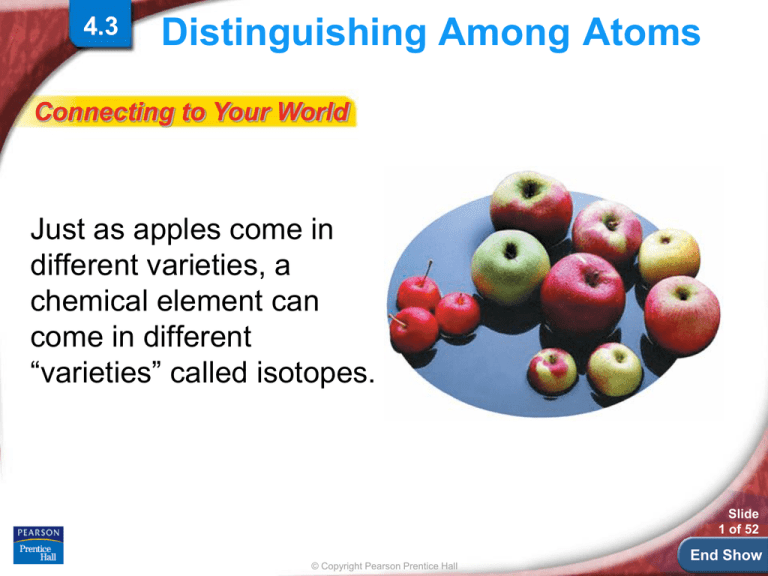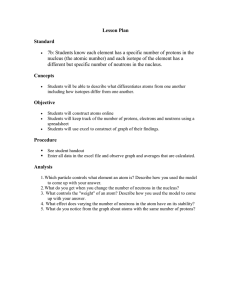
4.3
Distinguishing Among Atoms
Connecting to Your World
Just as apples come in
different varieties, a
chemical element can
come in different
“varieties” called isotopes.
Slide
1 of 52
© Copyright Pearson Prentice Hall
End Show
4.3
Distinguishing Among Atoms
>
Atomic Number
What makes one element different from
another?
Elements are different because they
contain different numbers of protons.
The atomic number of an element is the
number of protons in the nucleus of an
atom of that element.
Slide
2 of 52
© Copyright Pearson Prentice Hall
End Show
4.3
Distinguishing Among Atoms
>
Atomic Number
Elements are different because they
contain different numbers of protons.
The atomic number of an element is the
number of protons in the nucleus of an atom
of that element.
Slide
3 of 52
© Copyright Pearson Prentice Hall
End Show
4.3
Distinguishing Among Atoms
>
Atomic Number
Slide
4 of 52
© Copyright Pearson Prentice Hall
End Show
Slide
5 of 52
© Copyright Pearson Prentice Hall
End Show
Practice Problems for Conceptual Problem 4.1
Slide
6 of 52
© Copyright Pearson Prentice Hall
End Show
4.3
Distinguishing Among Atoms
>
Mass Number
How do you find the number of neutrons
in an atom?
The total number of protons and neutrons
in an atom is called the mass number.
The number of neutrons in an atom is the
difference between the mass number and
atomic number.
Slide
7 of 52
© Copyright Pearson Prentice Hall
End Show
SAMPLE PROBLEM 4.1
Slide
8 of 52
© Copyright Pearson Prentice Hall
End Show
SAMPLE PROBLEM 4.1
Slide
9 of 52
© Copyright Pearson Prentice Hall
End Show
Practice Problems for Sample Problem 4.1
Slide
10 of 52
© Copyright Pearson Prentice Hall
End Show
4.3
Distinguishing Among Atoms
>
Isotopes
Isotopes
How do isotopes of an element differ?
Isotopes are atoms that have the same number
of protons but different numbers of neutrons.
Because isotopes of an element have
different numbers of neutrons, they
also have different mass numbers.
Slide
11 of 52
© Copyright Pearson Prentice Hall
End Show
4.3
Distinguishing Among Atoms
>
Isotopes
Despite these differences, isotopes are
chemically alike because they have identical
numbers of protons and electrons.
Slide
12 of 52
© Copyright Pearson Prentice Hall
End Show
Slide
13 of 52
© Copyright Pearson Prentice Hall
End Show
Practice Problems for Conceptual Problem 4.2
Slide
14 of 52
© Copyright Pearson Prentice Hall
End Show
4.3 Section Quiz
Assess students’ understanding
of the concepts in Section 4.3.
Continue to:
-or-
Launch:
Section Quiz
Slide
15 of 52
© Copyright Pearson Prentice Hall
End Show
4.3 Section Quiz
1. Isotopes of an element have
a. the same mass number.
b. different atomic numbers.
c. the same number of protons but different
numbers of neutrons.
d. the same number of protons but different
numbers of electrons.
Slide
16 of 52
© Copyright Pearson Prentice Hall
End Show
4.3 Section Quiz
2. How many neutrons are in sulfur-33?
a. 16 neutrons
b. 33 neutrons
c. 17 neutrons
d. 32.06 neutrons
Slide
17 of 52
© Copyright Pearson Prentice Hall
End Show





